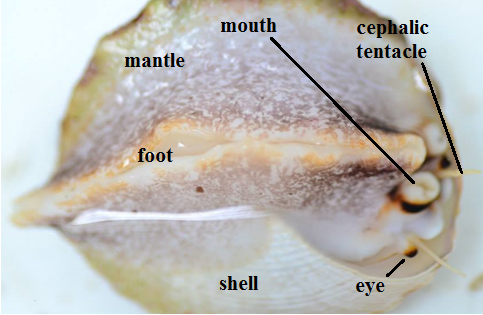Life History, Anatomy & Physiology
 
Figure 8. External structures of snails from the Trochidae family.
The T. stellatus make part of the prosobranchs- that is not a true classification, but fits for the educational purposes- which is mostly composed by benthic marine animals (Ruppert, E. E. et al, 2004). The T. stellatus uses its foot for locomotion, which on hard substrates moves rapidly by wave of muscular contractions. It can stay attached to the bottom by the sole that produces sticky and gelatinous mucus (Figure 8). The majority of the prosobranchs are gonochoric (Ruppert, E. E. et al, 2004). As others gastropods, Trochidae lost left gonad, and only the right gonad is present. Those animals usually do not have copulation and the fertilization is externaland occurs in the sea (Ruppert, E. E. et al, 2004).
As already said, the T. stellatus is an important algae consumer. The radula of those individuals might be highly developed, and work as a grater (Ruppert, E. E.et al, 2004). As well as every gastropod, at least a part of the digestion is extracellular. Usually the stomach is the place where the extracellular digestion takes place, while the digestive ceca are responsible for the intracellular digestion- when it occurs- and by the absorption. Theirs nervous system is cephalized, and the sensory system well developed (Ruppert,E. E. et al, 2004). Theirs sense organs includes eyes, tentacles, osphradia, statocysts and a magnetic sense (Ruppert, E. E. et al, 2004)
|